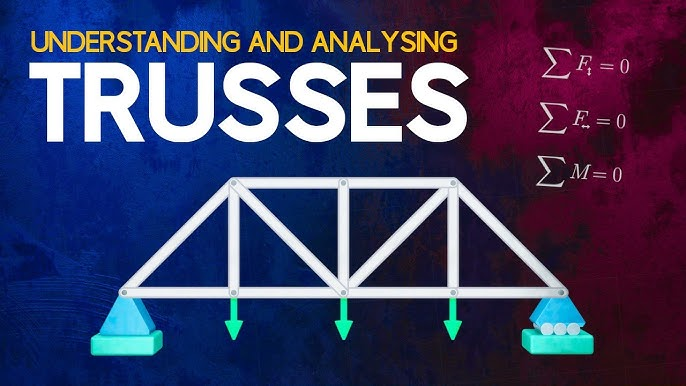A Brief Overview of Trusses in Engineering Mechanics
In the field of engineering mechanics, trusses are one of the most fundamental structural systems. They are extensively used in bridges, roofs, towers, and various other structures due to their strength, efficiency, and versatility. Understanding trusses is essential for engineers as they are an integral part of designing safe and stable structures.
What is a Truss?
A truss is a framework composed of members (usually straight beams) connected at their ends to form a rigid structure. The members are primarily subjected to axial forces (tension or compression) and are arranged in triangular units. This triangular configuration provides stability and ensures that the structure can distribute loads efficiently.
Key Characteristics of Trusses
-
Structural Efficiency
Trusses are designed to carry loads with minimal material usage. Their geometry allows forces to distribute evenly, making them both lightweight and strong. -
Triangular Framework
The triangle is the simplest geometric shape that remains stable under load, unlike rectangles that can deform under pressure. This stability is the basis of truss design. -
Axial Loading
The members of a truss experience only tensile or compressive forces, with minimal bending or shear. This simplifies analysis and ensures optimal material usage.
Types of Trusses
-
Based on Shape:
- Pratt Truss: Diagonal members are inclined toward the center, ideal for vertical loads. Common in bridges.
- Warren Truss: Equilateral triangles form its structure, distributing loads evenly.
- Howe Truss: Diagonals incline away from the center, used in both roofs and bridges.
- King and Queen Post Trusses: Simple forms, primarily used in roofs.
-
Based on Application:
- Roof Trusses: Designed to span large distances while supporting the weight of the roof.
- Bridge Trusses: Capable of carrying heavy traffic loads across long spans.
Analysis of Trusses
Truss analysis involves determining the forces in each member under applied loads. Two primary methods are used:
-
Method of Joints:
- Focuses on the equilibrium of each joint.
- Based on Newton’s laws, the sum of forces in the horizontal and vertical directions must be zero.
-
Method of Sections:
- Cuts the truss into sections to analyze a specific part.
- Useful for finding forces in specific members without analyzing the entire structure.
Applications of Trusses
-
Bridges:
- Truss bridges, such as the Pratt or Warren types, are widely used for their ability to span long distances and handle significant loads.
-
Buildings:
- Roof trusses provide support for large roofs without internal columns, ensuring open interior spaces.
-
Towers and Cranes:
- Their lightweight yet strong design makes trusses ideal for towers and crane arms.
Advantages of Trusses
- Material Efficiency: Reduced material use without compromising strength.
- Versatility: Suitable for a wide range of applications.
- Ease of Construction: Prefabricated truss components are simple to assemble.
- Stability: Exceptional stability under varying loads.
Conclusion
Trusses are a cornerstone of structural engineering, demonstrating how simple geometric principles can solve complex real-world challenges. Their efficient design and widespread applications make them indispensable in modern engineering. Mastering truss analysis and design is not just an academic exercise but a practical skill for aspiring engineers.Whether you're designing a roof or a bridge, trusses embody the perfect blend of form and function, providing both strength and beauty to engineered structures.



Comments
Post a Comment